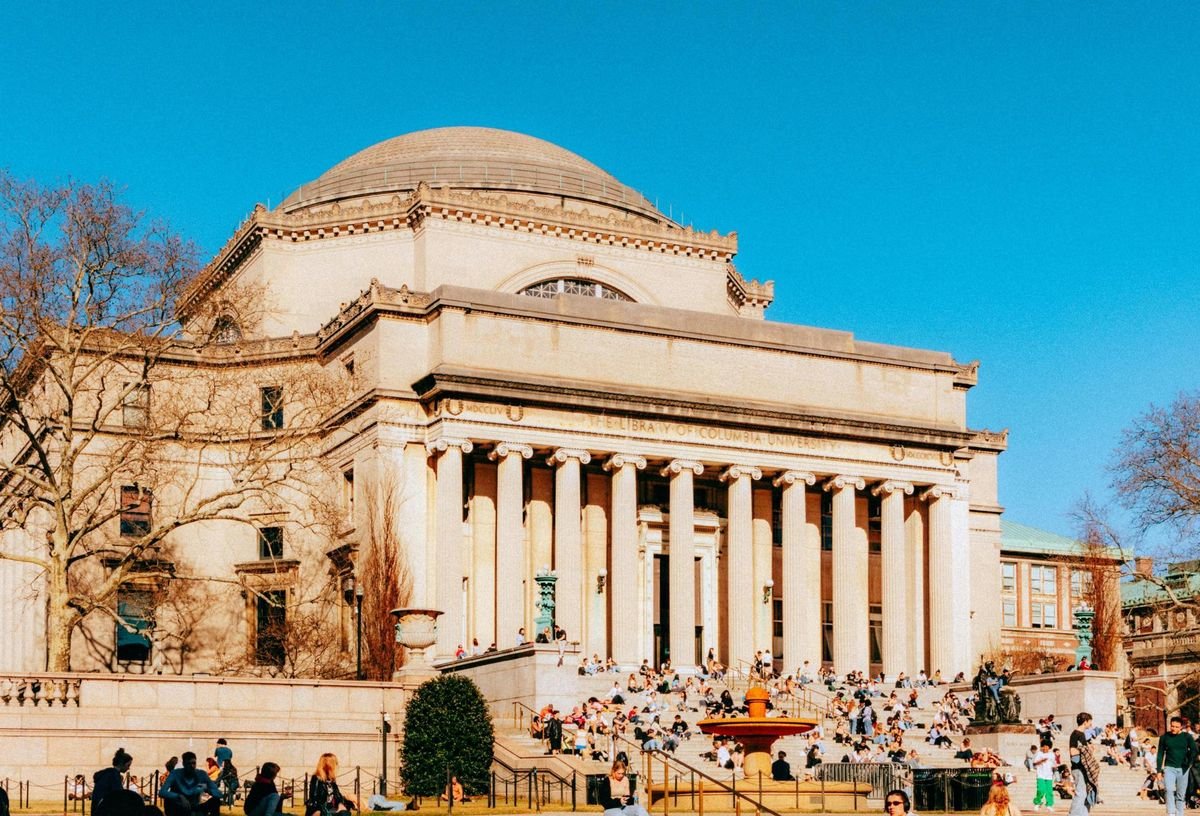New York City’s largest private landlord, Columbia University, is facing a barrage of financial attacks, from federal funding freezes to heightened taxes, from President Donald Trump’s administration. Protecting it is a shield of at least 245 properties and a $14.8B endowment war chest.
Its liquidity-constrained peers, however, have been left more vulnerable — as has their real estate.
“They’re all under the gun with Washington, but [large institutions] have major endowments, and they have some wherewithal to resist this for a while,” Cushman & Wakefield Executive Managing Director David Lebenstein said. “When you’re a smaller, mere mortal group, it’s not as easy to stem the tide.”

Columbia University’s campus is in Morningstar Heights, but its real estate holdings cover a wide swath throughout Manhattan.
New York City’s higher education institutions have diverse real estate holdings, ranging from dorms and multifamily buildings to office and laboratory space, scattered across the city. In 2023, private colleges owned about 25M SF of city land, according to a Crain’s New York Business.
Those assets could be a key backstop for schools if they need to raise capital.
“Something’s going to have to give somewhere, unless a benefactor wants to make up the gap,” said Lebenstein, who oversees Cushman’s not-for-profit advisory group.
Trump has bombarded elite universities, especially Harvard University and Columbia, with a series of executive orders, citing violence and antisemitism arising from pro-Palestine campus protests.
Among those actions, he has threatened to strip the schools of their accreditations and tax exemptions, suspended and revoked foreign students’ visas, and frozen federal funding. He has already clawed back $400M from Columbia, with more grant cancellations expected.
Most recently, the One Big Beautiful Bill, which passed last week, introduced a tax structure based on private schools’ “student-adjusted endowment,” or the size of their endowment divided by the number of eligible students. That hikes the existing flat 1.4% excise tax to as much as 8% for some schools, including Columbia.
Harvard and Columbia are reinforced by massive endowments — the first- and 12th-largest among U.S. universities. In the city, New York University is Columbia’s closest rival in terms of endowment size, with $5.9B.
Others have much less to fall back on. Despite having more than three times the enrollment of NYU, the City University of New York has just $1.1B in endowment assets, according to a report by the Commission on Independent Colleges and Universities. Fordham’s is of similar size, totaling $1B as of 2024, whereas Pace University’s investments, including its endowment, were $237M in 2023.
Those schools could be collateral damage in the Trump administration’s efforts to roll back science and research funding.
Columbia declined to comment on this story. Several other New York City-based higher education institutions, including NYU, Pace University and CUNY, didn’t respond to Bisnow’s request for comment on impacts to their portfolios. Fordham University declined to comment.

569 Lexington Ave., a 578-bed dorm acquired by the City University of New York this year
Trump has also called for the dismantling of the Department of Education, threatening outside scholarship sources — including $2.7B in Pell Grants — and federal student loan servicing.
More than 2,600 federal research grants, 318 of which are in New York, have been terminated since January, according to Grant Watch, a nonprofit tracker of federal health and science grants canceled by the Trump administration.
“A major portion of Columbia and other similar institutions’ revenues comes directly from federal research contracts,” Open Impact Real Estate Senior Vice President Jake Cinti said. “So wet lab space is going to be one of the first casualties.”
It already happened at NASA’s Goddard Institute for Space Studies’ Morningside Heights laboratory. Scientists were forced to move out of the Columbia-owned facility in May after its lease was canceled due to the president’s efforts to increase efficiency, Gothamist reported.
A NASA union representative told the publication that the General Services Administration sublet the space to NASA and continues to have a $3M a year lease with Columbia through 2031.
The building doesn’t appear on the GSA’s public inventory of leased buildings, and an Avison Young database of the GSA’s current and canceled leases doesn’t show the lab at 2880 Broadway. The GSA did not respond to Bisnow’s request for comment on the lease.
Despite the funding threats, schools continue to search for classrooms, administrative facilities and dorms, driven by a surge in students pursuing higher education, brokers said.
Although first-time postsecondary enrollment plummeted 13% nationally in 2020, they have since rebounded, according to the National Student Clearinghouse Research Center. In fall 2024, enrollment increased 4.5% year-over-year, surpassing prepandemic levels for the first time. Older first-year students were a significant driver of that growth.
Fall 2024 enrollment in CUNY’s community colleges was up 6% over the prior year, while graduate student enrollment grew 4%, the first increase in four years, according to the governor’s office.
In April, the school spent nearly $86M on a hotel converted into a dorm, operated by student and intern housing provider Found Study at 569 Lexington Ave. The deal adds 578 beds to the school’s portfolio, according to Crain’s.
More financially strained schools may have to outsource space from third-party providers and developers or consider leaseback agreements.
But if schools do begin to offload real estate, their better-capitalized counterparts could be presented with an opportunity. Last year, NYU bought an East Village dormitory building from Sherwood Equities and Bhatia Development for $69M after Marymount Manhattan College’s lease was terminated, Crain’s reported.
“Columbia and NYU are the two big gorillas,” Lebenstein said. “They’re major institutions that can buy whatever they want, whenever they want. And they’ve mostly been looking for dorm space, especially NYU.”

35 Cooper Square, a former Marymount Manhattan College dorm recently acquired by New York University
More creative transactions, such as ground leases or air rights transfers, may become a means of raising capital for schools or their other projects, Cinti said.
“New York City underwent one of the biggest rezonings since the last century,” Cinti said, referring to the City of Yes. “That’s leaving a lot of owners with additional air rights and increased flexibility in terms of how those can be transferred. That is an area that might offset what otherwise would involve financing.”
Columbia has been one of the biggest shapers of New York City’s built environment. In addition to the buildings it has long held and leased, the school has spent the past 17 years building its Manhattanville campus in West Harlem.
The master plan, proposed by University President Lee Bollinger in 2003, calls for a 17-acre campus from 125th Street to 134th Street between Broadway and 12th Avenue. It is expected to have 6.8M SF of academic space, more than an acre of green space and street-level commercial and civic facilities when completed.
Since construction began in 2008, the school has built five academic buildings and one residential tower. Phase 2 of construction is scheduled to be completed in 2030, but the funding cuts add an element of doubt to its plans.
In addition to tension posed by the Trump administration, the project has faced backlash from Harlem activists and politicians who claim that Columbia has failed to deliver on its community benefits agreements. State Sen. Cordell Cleare and Assemblymember Al Taylor have introduced legislation to halt Columbia’s use of eminent domain, which is how it has advanced much of the development.
“Columbia has been steadily expanding its presence around the Manhattanville campus, but financial constraints could slow or scale back future phases of that development,” Compass Vice Chair Adelaide Polsinelli said in an email. “Should federal funding remain frozen, the university might pursue public-private partnerships or increase commercial leasing activity within its campus footprint.”
Still, given Columbia’s standing, large changes to the master plan are unlikely, she added.
“Its tremendous real estate holdings give it both a buffer and a strategic lever,” Polsinelli said. “While federal funding cuts may shift priorities and delay projects, Columbia’s real estate portfolio positions it to navigate the challenges with strength and tons of optionality.”





